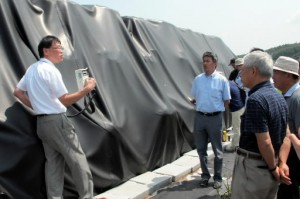Participants of the World Conference Against A & H Bombs visit Fukushima Prefecture to learn about radioactive waste from decontamination work
Aug. 1, 2014
by Jumpei Fujimura, Staff Writer
On July 28, about 30 participants of the World Conference Against A & H Bombs, including members of the Japan Congress Against A- and H-Bombs, visited Date City in Fukushima Prefecture to see a temporary storage site for radioactive waste from the decontamination work carried out after the accident at the Fukushima No. 1 (Daiichi) nuclear power plant. The city official in charge of the decontamination work explained to the group about the issues involved.
Currently, there are 108 temporary storage sites in Date City. They visited one such site in the rural part of the Taira District to see how the waste is held in storage, covered with rubber sheets. At the site are about 2,600 tons of waste from 40 households, including branches from pruned garden trees and scraped surface soil. Kiyomi Tanaka, director of the city’s Radioactivity Measurement Section, said, “The city couldn’t determine where to put the temporary waste sites, so we asked the neighborhood associations to discuss this matter among them and decide the locations.”
In Date City, the decontamination work within residential areas was completed in March. The city is now expanding the decontamination work to farmland and forests, which account for 75 percent of the city’s total area. Mr. Tanaka said, “People would like us to decontaminate the whole area thoroughly, but if we apply the same methods as we used in the residential areas, we will need about 140 billion yen. The cost is borne by the national government, but it’s difficult to decide the best course of action.”
The group also visited the public waste water treatment plant at Kunimi-machi in Fukushima Prefecture. Inside the compound, 25,000 tons of sludge, equivalent to about two years of sludge, are kept under 69 tents. The person in charge said, “Since the sludge includes radioactive materials, private companies refuse to take it. We are waiting for the national government to create a treatment facility.”
(Originally published on July 29, 2014)
On July 28, about 30 participants of the World Conference Against A & H Bombs, including members of the Japan Congress Against A- and H-Bombs, visited Date City in Fukushima Prefecture to see a temporary storage site for radioactive waste from the decontamination work carried out after the accident at the Fukushima No. 1 (Daiichi) nuclear power plant. The city official in charge of the decontamination work explained to the group about the issues involved.
Currently, there are 108 temporary storage sites in Date City. They visited one such site in the rural part of the Taira District to see how the waste is held in storage, covered with rubber sheets. At the site are about 2,600 tons of waste from 40 households, including branches from pruned garden trees and scraped surface soil. Kiyomi Tanaka, director of the city’s Radioactivity Measurement Section, said, “The city couldn’t determine where to put the temporary waste sites, so we asked the neighborhood associations to discuss this matter among them and decide the locations.”
In Date City, the decontamination work within residential areas was completed in March. The city is now expanding the decontamination work to farmland and forests, which account for 75 percent of the city’s total area. Mr. Tanaka said, “People would like us to decontaminate the whole area thoroughly, but if we apply the same methods as we used in the residential areas, we will need about 140 billion yen. The cost is borne by the national government, but it’s difficult to decide the best course of action.”
The group also visited the public waste water treatment plant at Kunimi-machi in Fukushima Prefecture. Inside the compound, 25,000 tons of sludge, equivalent to about two years of sludge, are kept under 69 tents. The person in charge said, “Since the sludge includes radioactive materials, private companies refuse to take it. We are waiting for the national government to create a treatment facility.”
(Originally published on July 29, 2014)








